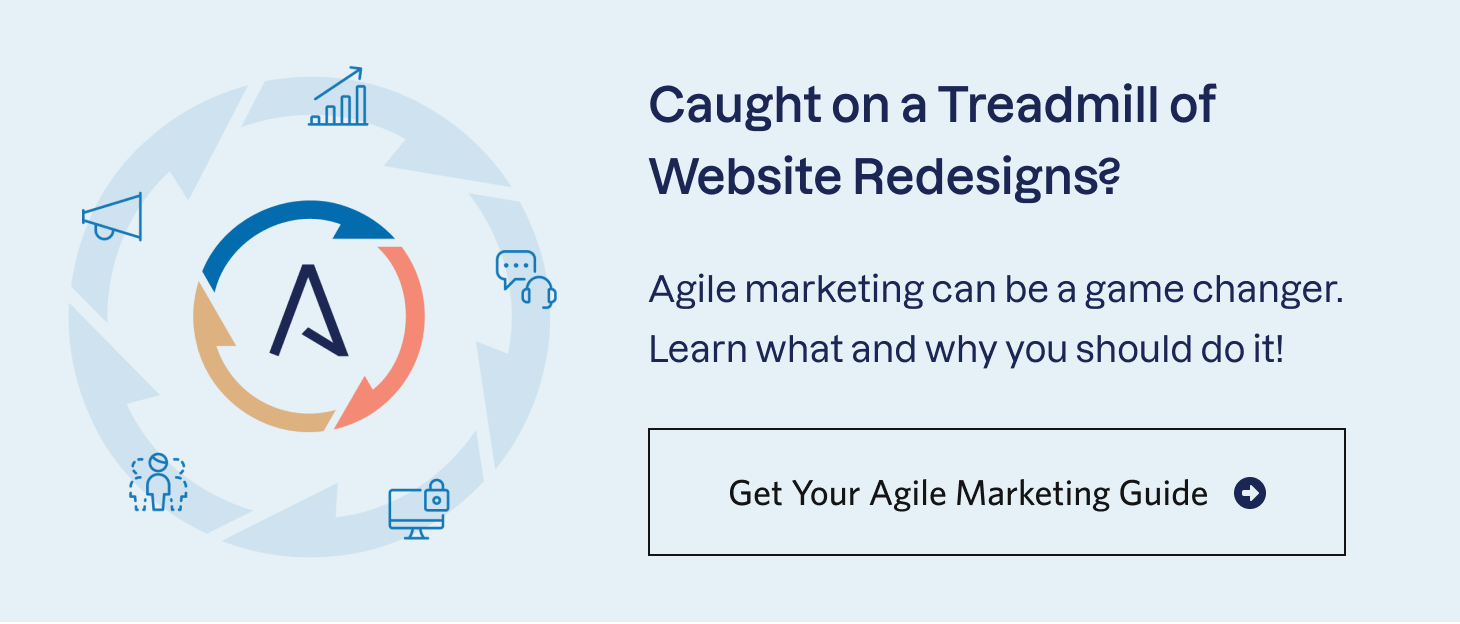Website Redesigns are Dead — Do This Instead
For marketers, a website redesign is the ultimate mixed blessing.
Seen as an inevitability, a redesign provides your website with improvements such as an updated look and an overhauled CMS. But along the way, you have to manage a complex project that easily overwhelms your team and your annual budget. Plus, you still have to do your regular job in addition to managing a massive project.
You have every reason to dread the whole miserable process. So why bother?
Obviously, no organization can ignore its digital needs and stay competitive. But the days of throwing away an ineffective website in the pursuit of a big “ta-da” reveal of a new design every few years are over. Rather than viewing your website as technology that inevitably falls into decline, you should consider it a collection of building blocks with the potential for constant improvement, flexibility, and scalability.
By establishing a strong digital foundation, you can incorporate the critical updates your website needs in a way that keeps its core – and your sanity – intact. The answer is an iterative website strategy.
Focus on Evolution – and Your Users – in Any Redesign
In the traditional model of website management, businesses have expected to need a redesign every 3 to 5 years. But starting from scratch with your digital presence isn’t just difficult, expensive, and time-consuming – it’s also impractical.
When your organization begins the long journey toward a new website, you inevitably introduce a gap in your information. As you and your stakeholders focus on resolving your next website’s needs, your current users inevitably fade out of the picture. From a content marketing standpoint, you’re missing out on useful customer data as your website is being rebuilt.
Plus, large-scale redesigns are risky. For example, when Facebook introduced a new timeline view to replace its familiar profile pages in 2012, its users revolted. Consequently, Facebook incurred the expenses of rolling back its redesign to avoid alienating its customers. Instead, the company opted for an incremental approach to changes.
Your business should take the same approach. Rather than providing a jarring experience for users unable to find what they need, you should view your redesign as a constant evolution.
The model that demanded you redesign your site every few years is dead. Frankly, given the pace of digital business, that timeline simply isn’t fast enough. Instead of viewing your site as a one-and-done undertaking, think of it as a living organism not unlike a garden. If you provide your site with consistent, iterative care and maintenance, it will deliver the growth your business needs.
Pursue a Flexible Website Design That Grows With Your Needs
Given the advances in how websites are built and maintained, organizations with old sites can still see real opportunities in a comprehensive redesign. Frankly, depending on your site’s current capabilities, you may be unable to avoid making one big leap forward before moving into a more iterative model.
Once you’ve secured the budget for a redesign, you can bridge the gap from your site’s current state by transitioning to tools with greater flexibility. The right digital agency can help migrate your site to a modern platform that will eliminate the need for another comprehensive redesign in the future.
With open-source website tools like Drupal and WordPress, your website’s capabilities evolve in accordance with the platform’s developer community. As a result:
- Your organization gains increased access to new site features, which are built and deployed in response to the community’s needs.
- You have the means to focus your redesign on securing a new platform and CMS, which can support iterative improvements to your site’s user experience.
- Instead of undertaking a long journey toward a redesign that fulfills every item on your wish list, you can focus only on the features you need first, while creating a backlog for future improvements.
- You benefit from the flexibility to approach your website as a constant work in progress.
With your website on a secure foundation, your organization can work down its backlog of features according to your most pressing needs.
Integrate Analytics to Inform Your Design Priorities
If your website is built on an out-of-date platform, you’re not only missing out on better tools to provide a more satisfying experience for users. You’re also missing the ability to gain ready insights into their behavior that will inform your content priorities moving forward.
An updated platform integrated with Google Analytics allows you to understand how well your site is performing. Without the right data, marketers face too many variables that could impact performance of a given page, form, or feature. Without usable insights, any design changes you ask your developers to implement are essentially informed by guesswork.
However, modern user analytics gives you the ability to recognize and respond to user behavior. If your team updates the layout of a given form, your analytics dashboard will quickly illustrate the results. Plus, with the right tools, your team can create and implement the updates your users need without any developer assistance.
Empower Your Marketing Team With the Tools of a Flexible Design System
With the ability to learn from users in real time, you can optimize your website to better serve their needs. Tools like the WordPress Block Editor — which supports multiple layouts, media types, and formatting — allow you to implement site changes and see how the results will look. The Block Editor gives your marketing team the ability to iterate quickly without worrying they might break the site or disrupt its design.
Similarly, once your site has migrated to a new platform, you gain the flexibility of applying principles of component-driven development.
Enter the pattern library. Like a style guide that dictates a brand’s standards in physical media, a pattern library provides your team with a resource that displays each component of a given form or page layout on your site. This allows your marketing team to access the building blocks of every page on your site, while also supplying documentation and peace of mind. Rather than needing an outside agency to develop new features, your team can quickly build landing pages that are functional, accessible, and consistent with your design standards.
In the traditional redesign cycle, organizations depended on developers to deliver a new experience that inevitably grew out-of-date. However, when your website is on a firm yet flexible foundation, your marketing efforts remain nimble and responsive. Instead of relying on a long redesign process, your teams are empowered to quickly create the features your users need. In today’s business climate, that’s the redesign schedule you need to stay competitive.

